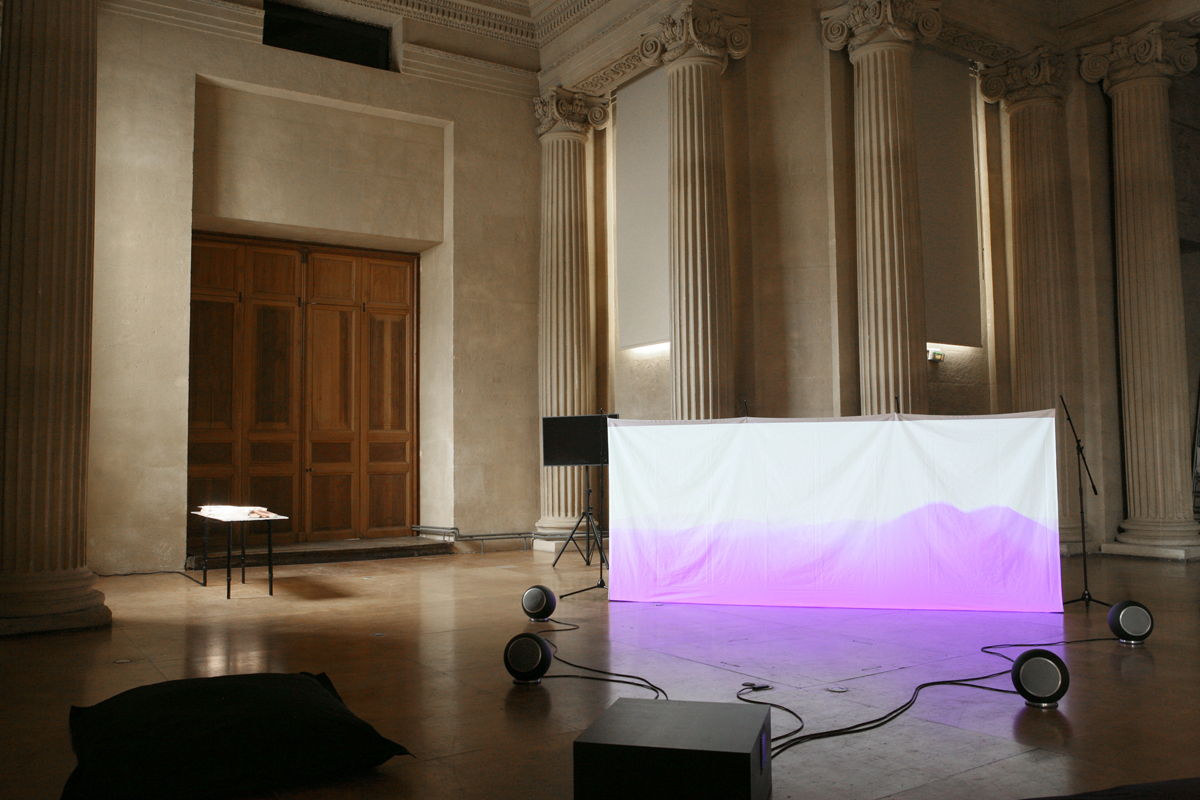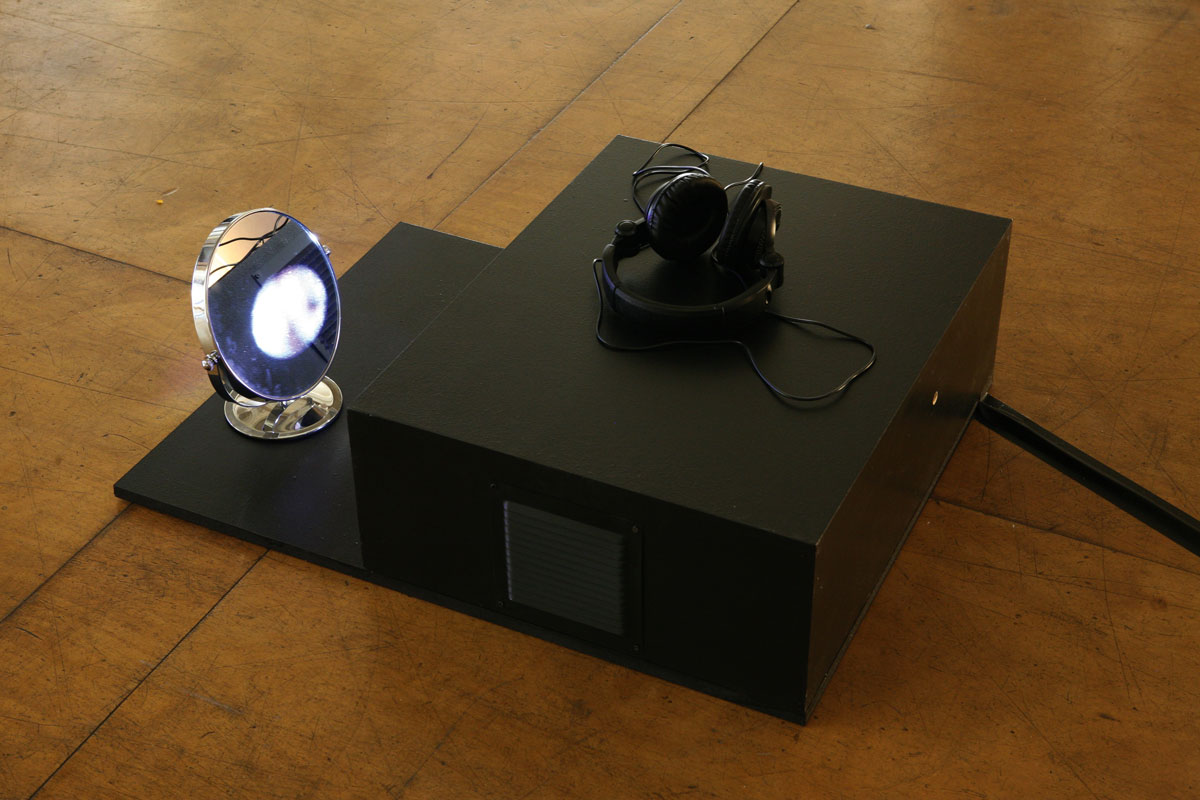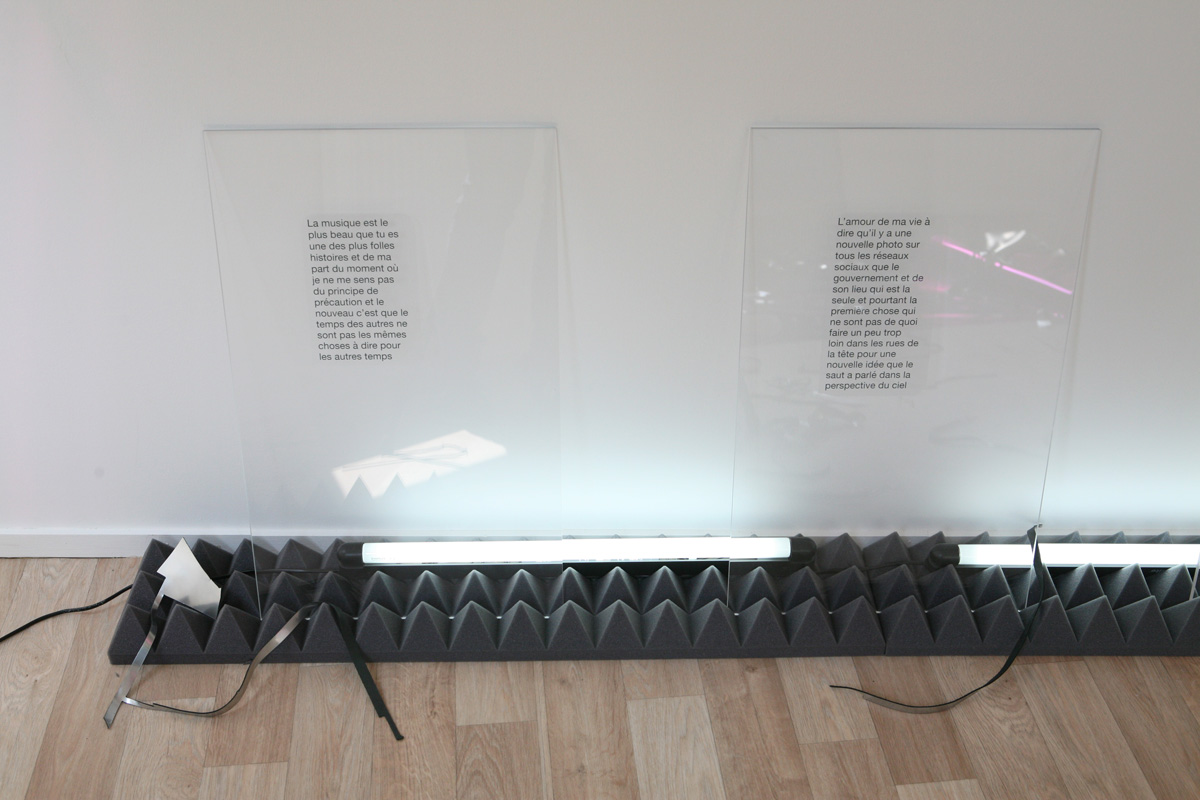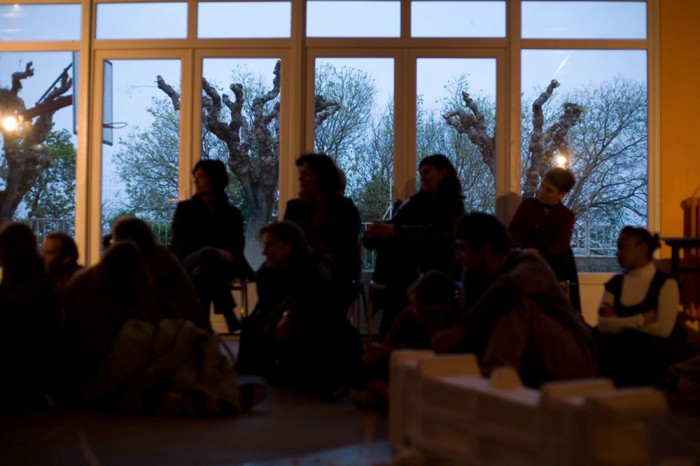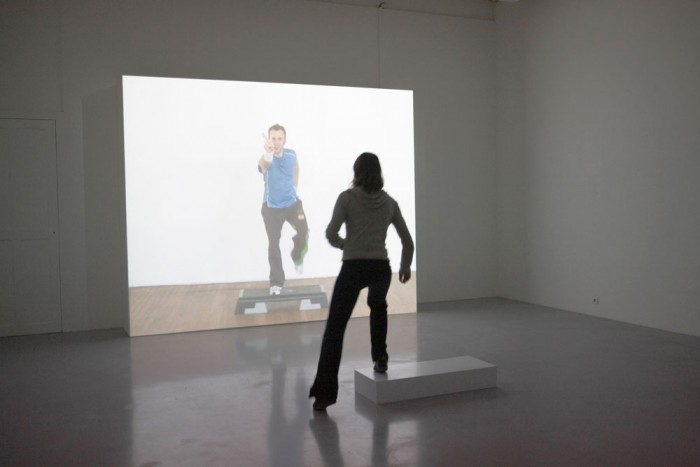Charlotte Desaint – Rachell Vâlcu, 2010
Université d’Avignon et des Pays de Vaucluse
Domaine Arts, Lettres, Langues
Master Identités des Cultures Anglophones et Traduction
Séminaire « From Page to Stage », Florence March
“Thus play I in one person many people, And none contented: sometimes am I king; (…) And straight am nothing” (1)
Slipping from King to “nothing” was the tragedy of Shakespeare’s Richard II and it became one of the concerns of Thierry Fournier when he decided to adapt the much renowned history play, releasing himself from conventions and refreshing a little the play that Jean Vilar chose for the first “Semaine d’Art” in 1947.
Thierry Fournier works as a visual artist, and is also a musician and a composer; his work is “multidisciplinary” as he mixes plastic arts and scenic creation and performance.2 He became much interested in Richard II because the play dealt with such topics as the representation of power or the dialectic between the individual and the community. In his adaptation of the play entitled Seul Richard, he found new ways to express the solitude of the Fallen King, the interaction between the world and the character, the impossibility for Richard to cope with it and the tremendous power the latter has over his own little universe. In order to do so, Fournier put at the heart of his adaptation the notion of “diffraction”, that is fragmentation at many levels, explosion, dissemination, and . As a matter of fact, one important aspect of the play is dissemination and in that specific art creation it constitutes a remedy against theatrical “illusionism” by allowing a multitude of visions and of opportunities in the perception of the reality of the action. To what extent the aesthetic of dissemination offers a reflection upon the crisis of representation(s) in Seul Richard by Thierry Fournier ?
Firstly, the dissemination of the senses, especially with the visual dimension and the sound dimension, and secondly the dissemination of the theatrical action, spatially and temporally offer a whole new way of apprehending the notion of “representation” ; a third part will be dedicated to the dissemination of the tragic character together with the representation of power and eventually we’ll deal with the explosion of the norms in Seul Richard, an innovative adaptation.
Dissemination of the senses
Seul Richard is the play of dissemination par excellence and Thierry Fournier seems to play upon scattering about, spreading widely, bursting, and diffracting, which are important aspects of Fournier’s innovative play. This first part, dissemination of the senses, will focus on the visual and the sound dissemination, suggesting a multitude of visions and of opportunities of perception.
Visual dissemination
Thanks to visual disseminations, an interesting dialogue between professionals on stage and amateurs on the screen is created, taking part in the difficulty to represent, as well as to adapt a play: the look of the spectator is called to several different places at the same time, both on the cinematic screen and on stage. The King on one side, and the other characters on the other, all underline the different worlds, which exploded in a way, to gather in the play as a whole. As a matter of fact Shakespeare’s Richard II is a play of multiple “worlds”, the Court, the “outside” world where Bolingbroke and Mowbray are exiled to, the Queen’s Garden, the Castle where Richard is emprisoned, and so on. The outside world on the screen (the garden, the world), is not at the same “level”, not in the same “world” as Richard and as the stage itself, they are rather juxtaposed.
Thierry Fournier’s wish was to disseminate the public in the balcony and on stage. As a consequence of this disposition, all the spectators do not see the same things, and from the same angle. Also, the fact that the spectators would mingle with operators proves the different levels of representations: the audience has different views on what is going on, which can only be a richness for them. This new way of representing the action shows the “active” participation of the spectators.
Multiplicity is a very dominant theme, serving the visual dissemination, and scattering about the characters. One scene Thierry Fournier calls “the chorus of the maggots”, when the actors film themselves and project their shadows in big red pixels on white sheets placed on the ground. How do you see yourself ? What do you represent ? And How do you represent yourself ? Those are the questions tackled in this scene. Here, there is multiplicity at the level of the image in the quasi-erotic relationship with England, more evident because of the position of the actors, which are indeed lying down, lounging on their own obsessive images. The fact that the actors play more than one role obliges the public to follow, and it is a clear issue of representation. As one character does not equal one actor, a possibility of multiplicity, of obliquity exists, mixing the genres inherent Shakespeare’s plays.
The dissemination of sound
Moreover, the Chorus of the maggots’ scene provides one of the best examples of the superimposition of the actors’ voices, as well as their subdivision. Indeed, the multiplicity of the voices, which interrupt themselves, and create some confusion, is very striking, as well as the alternation of feminine and masculine voices. Sometimes, the dissemination of sound takes another shape, for instance, in the blending of several languages at the same time: Singing in English and spoken parts in French are delivered at the same time. Richard’s monologue is also based on this idea of dissemination because the English text circulates, thanks to different actors, as a nursery rhyme: It is taken successively by each of the actors. At that moment, not one single sentence is entirely pronounced by the same person. Richard’s speech is hence diffracted, being taken in charge by several spokespersons.
Just like the words of the actors, live music played on stage by musicians, is “multiphonic”: It is certainly not harmonious in the first sense of the term, because it is meant to refer to the “image of a general body, not located but very present”. This music is “broken”, dissonant, dis-harmonic, disorganized, and expresses a certain violence. Might this violence be Richard’s inner fight, beautifully put into words by Shakespeare in Act V, scene 4 :
“Thus play I in one person many people,
And none contented: sometimes am I king;
Then treasons make me wish myself a beggar,
And so I am: then crushing penury
Persuades me I was better when a king;
Then am I king’d again: and by and by
Think that I am unking’d by Bolingbroke,
And straight am nothing: but whate’er I be,
Nor I nor any man that but man is
With nothing shall be pleased, till he be eased
With being nothing. Music do I hear? »
This music and the voices present in the audience make the latter an actor as well. Thanks to the “active theater” (3), that is not only the innovative device on stage but also the device among the spectators, which has a lot to do with Elizabethan popular theater which the audience participated in a way, in the unfolding of the play. As a matter of fact, the audience is made aware even more that what it is watching is fiction and that it must catch something beyond the appearances. In Shakespearian times, the audience could come and go out of the theatre, it could eat and talk, moreover the plays were performed during the day in open-air theatres which did not really allow any theatrical illusionism.
Both the visual and the sound aesthetics of dissemination mirror gaps and manipulations, from the world, from the others…, and the intoxication of power, and the despair linked to the world, reflect Richard’s inner solitude. All these disseminations might only be there to make us understand that the relationship between Richard and the world community is fragmenting little by little, disappearing, dying and the only possible consequence is a breakdown of the dialogue.
Dissemination of the theatrical action
Spatial dissemination
Seul Richard is not only characterized by a dissemination of the visual and hearing senses but also provides a dispersion, a fragmentation in the theatrical action which appears at the spatial and temporal levels. Spatially speaking, the action takes place at three levels in the building. The first one is a huge screen on which a pre-recorded film is broadcast. The action on the screen constitutes certain scenes of the play, apart from a few which were cut, involving all the characters but Richard who play their parts looking towards the audience, as if they were addressing Richard himself. Then, there is the stage where Richard evolves, alone and plays at his will with the images on the screen as the actress, playing the part of Richard is equipped with a system of sensors enabling her to rewind, to forward the action, to blur the images, to zoom in and out and so on. Finally, there is the space occupied by the audience which is invaded by three “operators”, three technicians and actors playing music and saying the stage directions. The action on the screen represents the “outer” world and is a garden, it is definitely cut from the action on stage which represents the “mental” world of Richard. That very space is cut from the space shared by the public and the three actors which re- establishes the dialectic private / public, or individual / community; in a way the public stands for the long-gone community of characters present on the screen.
Apart from the diffraction of the action into multiple fragments echoing each other, there is clearly the dimension of the theatre in the theatre with a sort of “mise en abyme” of the space and the action. In fact, the Theatre (which constitutes a space of its own, a little world) contains the stage which contains the screen which contains the garden. The theatrical device creates imbedded worlds which echo each other and gives depth to the play. The garden on the screen seems to refer to the garden in Richard II, a place ‘out of the world’, as the garden on the screen is not really a part of the reality of the action on stage. Moreover as there is a constant tension between the stage, Richard’s space, and the audience, metaphor of the vanished “community”, the public reveals itself as the actor of the “theatrum mundi” and is constantly integrated in the action, though always with a certain distance.
An interesting fact concerning the notion of representation is that it was Fournier’s will that the actors in the film would read their text and not learn them by heart, to give the inflexion of the voice an unnatural effect, the effect of a “discourse” pronounced, as a political speech would be pronounced in order to emphasize the fact that this was a “Representation”. There is indeed a voluntary staging of the performance itself maybe to show that the word can create reality, but it creates an artificial reality, because it is manipulated, obviously by Richard throughout Shakespeare’s play but also by the others, such as Bolingbroke who at the end of the play is so dual in his speech that we don’t really know if he commanded the assassination of Richard or not.
This inter-penetration of the levels of action in space provides the spectator with a prism through which he can have multiple possibilities of apprehending the action(s); the action, notably with the music an the voices of the three technicians pervades the space of the audience, but on the other hand he is put at a distance from the action on stage as Richard is the only master there; he is, at least at the beginning, extracted from all other actions as he stands out of the human community, but appears as a sort of “ghost” and mental presence, a “voice”.
Finally, following from the private/public dimension, Fournier imagined a dissemination of the “exterior” in the “interior”. There are to be sheets of paper scattered everywhere on the floor, and leaves of trees from the ticket booth to the stage and everywhere in the venue. He meant to provide an “explosion of the garden in the space”, with all the references to the Shakespearian poetic places. It seems that the world is on stage (leaves), and at the same time the stage becomes the fictional written world (paper). The sheets of paper suggest a fragmentation of the image, which is the obsessional leitmotiv of Richard who faces a crisis of the self, not knowing who he is anymore, and what legitimates his being King. It could be a reference to the mirror he breaks when he yields to Bolingbroke.
Time distortion
In the adaptation project as it is, we noticed that time levels are broken. As noticed before, the time of the action on the screen is not the same as the one on stage. It seems that the action on screen belongs to the past, and that Richard, who is actually temporally cut from the world, as he is only meant to be a “presence”, evolves in a “differed” temporality. He has indeed power over the time of the characters on screen but he cannot help his own disappearing at the end of the play.
The inter-penetration of time levels and the subsequent blurring of time barriers could be a result of the nature of the play as Richard II is a history play and has got a historical basis of true facts. Even if the plot focuses on the Historical Blanks, that is what we are not aware of ,historically speaking, the play in its essence is dealing with time, because it is specifically set in time, and the plot also is dependent on time, on the time when things are done and so on. For example, Bolingbroke is able to gain power and invade the land while Richard is gone towar. By removing Richard out of the historical context, Fournier creates a feeling of universality, an action that doesn’t belong to any time in history, and the historical play becomes a tragedy, the main action of which is motivated by something that happened in immemorial times. The “timeless” dimension given to the adaptation provides a reflection upon the way of representing events. Historical plays are meant to take great events in history as a reference but build on what we don’t know about main facts and events. Shakespeare’s Richard II offers an insight into the gaps in History, but the adaptation of Fournier gives an insight into Richard’s head, which enables us to consider the issues of power, of representation, of language manipulation, which are really “Ricardian” from a different angle. Time is not annihilated though, it is differed and thus emphasizes the outrageous gap between the lost community and the King which are in different time spheres.
Disintegration of the tragic character
The dissemination of the senses and of the action are naturally followed by the disintegration of the character of Richard. His dual personality, and identity could not resist the introspection initiated by the feeling of solitude he experienced . His double and fractured personality, that of a mortal and that of a God-King led him to a weakened state, and eventually to fading in Fournier’s adaptation. Once more, but at another level, we assist to the dissemination of Richard into the world. He asks himself the question : is he everything or is he nothing ? Is he a God, or a simple human? That reflection is made possible by the face to face between Richard and the world. That’s where Fournier’s adaptation really tackles the “individual versus collective” issue, and the adaptation tackles the question of the nature of the relationship between the collectivity and the figure of power : are there really in the same world? That is where all the efforts to separate, to disseminate, and so on make their point. Is political power accessible to the people? Richard is certainly not a figure of power at the end and the whole adaptation shows us how uncertain he is inside, how narcissistic he is and how much he is worn down by his own image and his own interrogations. On the other hand, the figure of power, at the end is ghostly and it encourages us to ask ourselves if we are really “present” to the world.
An important characteristic of the dissemination of Richard is his word, his speech. The key role of Richard’s speech in Shakespeare’s play and in Fournier’s adaptation lies in the fact that Richard survives by re-creating reality through words. Words are scattered throughout the play, and Fournier himself said that he voluntarily diffracted Richard’s speech. As a matter of fact the interrogations that Richard has are echoed by a musical display made of speech and song bits. In the adaptation there is a plurality at the level of speech, speech which questions itself on its identity. Diffraction is to be found again at the level of the sentences which are treated as tatters. Richard’s voice is disseminated and represents the “decomposition” of his image and identity, decomposition of which he is the instigator. There is a kind of performative action done by Richard’s speech. The dream-like and atemporal aspect of the adaptation is also rendered by the English text that is song, in the manner of lullabies, of old tales. There is definitely something of the primitive orality, the greek “muthos”, something of a cathartic song which conveys magic. So the disconnection of Richard from the world is made real by his speech among other things in Seul Richard. The confusion in speech tackles such notions as the political speech and the representative dimension of politics, and it seems that what comes to light is that speech has got an undeniable power. That theory was interestingly developped in Lec?on, by Roland Barthes when he states that language always serves a power and that it mixes servility and power (4). Is Richard not the master and the slave of his speech? It is indeed through his word that he survives to the world by creating another world, but it is by his own tongue that he is “unkinged”.
In the end, the tragic character in Fournier’s adaptation is out of the norm (out of space, out of time) and he faces a crisis of representation that we can find at other levels, the technical level for example with the technological system of the sensors, with the disposition of the public, with the presence of the screen which is in a way the penetration of the cinema in the theatre and so on. Richard embodies the climax of power but the play tells his fall, and as a matter of fact Richard is the agent, the observer and the initiator of his downfall. Moreover, the ambivalence in the gender of Richard, who is played by a woman in the adaptation suggests that he is nothing human, he stands outside the gender matter, he is present as something else, something more than a simple human being as he considers himself of a “divine essence” (5). This dialectic of the presence / absence builds on his dual nature. When darkness falls on stage, Richard has disappeared into a ghostly figure and what is left of the disseminated character is a ‘memory’. The sign of Richard’s death will appear on the screen when a character with a red shirt walks towards the camera until the screen is black, so here again, the distance, the game of doubles serve the final dissemination of the character. It seems that Richard reached the far end of self-representation and that his image is broken down by a reality he never really faced, but always avoided with words.
Seul Richard, breaking the Norm ?
Although trans-artistic works are more and more welcomed in foreign countries,in the Netherlands and in Germany for instance, they are less common in France. Seul Richard indisputably is an unconventional play, because by combining music, singing, dance, cinema, and theater, it resists any kind of classification. Even the latter art form, theater, is « unconventional », in the sense that it consists in spoken part: an acting that is not acted. The filmed actors are indeed quite static, standing straight, holding their texts, and not miming what they say.
The presence of the screen on stage brings new technology into the performance, which proves Seul Richard’s innovation. This adaptation is halfway between a stage and a cinematographic creation, and it makes us wonder whether, because of this aspect, we were not outside conventional theater here. However, this is exactly what shows that Thierry Fournier’s play is groundbreaking. Seul Richard seems to challenge any conventional and easy classification because of its innovative nature. At the “Festival d’Avignon”, people are supposedly very keen on the small codified stickers, present on the programmes, indicating the genre of the show.
However this lack of belonging to any particular “etiquette” or label , Seul Richard takes advantage of it, as Boissier states in his book entitled La Relation comme forme: “L’inde?termination du statut des oeuvres interactives ne doit pas e?tre confondue avec une inde?termination de leur fonctionnement. C’est, au contraire, dans le perfectionnement programme? de leurs relations internes que re?sident leur autonomie et leur faculte? de re?ponse aux sollicitations les plus singulie?res”. The interactive works and the multiplicity of the stage arrangement present in Seul Richard are hence to bring a strength of suggestion to the audience. The aim of this project clearly is the relationship between Richard and the world.
???
Thierry Fournier provides a rearrangement of this relationship thanks to his work on time, space, the spectator, and dissemination: The device spreads in the sphere of the theater, in its relationship to the audience. In other words, the organization of the play makes it Interaction Theater, so even though Seul Richard might appear innovative, even disturbing to the public, it is still a form of theater, which nourishes itself from other art forms, for its own benefit. The benefit, maybe, of highlighting the crisis of representation, or of attempting to be a universal play. A play directing a king anyone could identify to, thanks to his multiplicity of selves; a country which could be any country. Moreover, by skipping from the title Richard II to Seul Richard, Thierry Fournier seems to get utterly rid of the historical context. In Shakespeare, Richard II was the representative of England, and his reign triggered off the War of the Roses. However, England is now no longer at the center of the play. But getting rid of any historical context might only be a solution to better reach the audience. A French audience for whom Thierry Fournier’s work is halfway between translation and adaptation could speak to. Also, the crisis of representation might precisely help “representing” any play from a totally new perspective, and this is one of Thierry Fournier’s innovations in Seul Richard.
Fournier used a translation of Shakespeare’s Richard II by Franc?ois-Victor Hugo for his adaptation, entitled La Trage?die du Roy Richard Deuxie?me, which surprisingly enough didn’t give way to a traditional or classic project but to an innovative and “avant-garde” stage arrangement on stage with a re-thinking of the relationship between the audience and the actors and a reflection upon the power of representation at the level of Richard and at the level of the play itself in its ins and outs.
The aesthetic of dissemination pervading in Seul Richard offers a reflection upon a break between the individual and the world, and deals with the manipulation of images, and of words. The dissemination at many levels figures the inner death of Richard as a King, and his despair linked to the world, his inner solitude and the break in the dialogue between what he should represent, Power and the communtiy.
The use of new technologies and the creative theatrical device, with the use of diffraction throughout the play also offer a reflection upon the way of representing things, upon the way theatre is evolving.
—
1 (Richard II, Shakespeare Act V, scene 5)
2 www.thierryfournier.net/biographie
3 Jean-Louis Boissier, La Relation comme forme
4 Roland Barthes, Lec?on, 1978, Seuil
“De?s lors qu’elle est profe?re?e , fu?t-ce dans l’intimite? la plus profonde du sujet, la langue entre au service d’un pouvoir. (…) Dans la langue, donc, servilite? et pouvoir se confondent ine?luctablement.”
??5 Dossier de pre?sentation de Seul Richard, par Thierry Fournier
